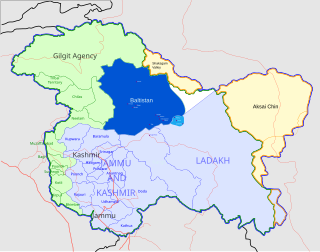
Baltistan (Urdu: بلتستان, Balti: སྦལ་ཏི་སྟཱན also known as Baltiyul or Little Tibet, is a mountainous region of Pakistan and India near the Karakoram mountains just south of K2. Baltistan borders Gilgit to the west, Xinjiang in the north, Ladakh on the southeast and the Kashmir Valley on the southwest. Its average altitude is over 3,350 metres.

Skardu is a city in Gilgit-Baltistan region of Pakistan, and serves as the capital of Skardu District. Skardu is located in the 10 kilometres wide by 40 kilometres long Skardu Valley, at the confluence of the Indus and Shigar Rivers at an elevation of nearly 2,500 metres. The city is an important gateway to the eight-thousanders of the nearby Karakoram Mountain range. The town is located on the Indus river, which separates the Karakoram Range from the Himalayas.

Skardu District is part of Baltistan and currently constitutes one of the ten districts of the Gilgit–Baltistan territory of Pakistan. It is bounded on the southeast by Kargil district in the Indian-Administered Jammu and Kashmir, on the east by Ghanche District, on the northeast by Xinjiang (China), on the south by Baramulla and Kargil District, on the west by district Astore and on the north by Gilgit District.

Ladakh is the highest altitude plateau region in India, incorporating parts of the Himalayan and Karakoram mountain ranges and the upper Indus River valley.
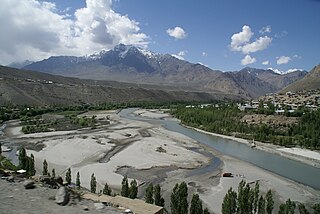
The Suru River, a tributary of Indus River, is a river in the Kargil district of Ladakh region, in the Indian state of Jammu and Kashmir.

The Dras River, also spelt Drass River, is a river in the Kargil district of Ladakh region, in the Indian state of Jammu and Kashmir.

The Ladakh Range is a mountain range in central Ladakh in the Indian state of Jammu and Kashmir with its northern tip extending into Gilgit-Baltistan in Pakistan. It lies between the Indus and Shyok river valleys, stretching to 230 miles (370 km). Leh, the capital city of Ladakh, is on the foot of Ladakh Range in the Indus river valley.

The Shingo River is a tributary of the Indus River, and flows through Gilgit-Baltistan and Kargil regions.

Pensi-la is a mountain pass in the Ladakh region of Jammu and Kashmir, which is known as the Gateway to Zanskar. Pensi La is 4,400 m (14,436 ft) above sea level and connects the Suru Valley region to the Zanskar Valley region. The summit at this end of the Suru Valley, the only peak which can be seen, is 7,012 m (23,005 ft) high, while the mountain to the north is 6,873 m (22,549 ft). The pass is about 25 km from Rangdum Monastery.
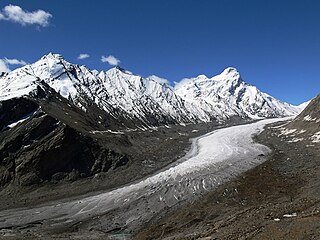
The Drang-Drung Glacier is a mountain glacier near the Pensi La mountain pass at the Kargil - Zanaskar Road in the Kargil district of Jammu and Kashmir in India.

Ladakh, a word which means "land of high passes", is a region in the state of Jammu and Kashmir of Northern India sandwiched between the Karakoram mountain range to the north and the Himalayas to the south and is situated at the height of 11,400 ft. The Indian portion of Ladakh is composed of the Leh and Kargil districts. The Leh district is the second largest district of India, covering more than half the area of Jammu and Kashmir, of which it is the eastern part.
Namika La or Namika Pass, Pillar of the Sky Pass, is a high mountain pass in the Himalayas Zaskar Range in India along the Srinagar-Leh highway at 34°22′N 76°35′E.

The Shyok River flows through northern Ladakh in India and the Ghangche District of Gilgit–Baltistan of Pakistan spanning some 550 km (340 mi).

Dras is a town in the Kargil District of Indian state of Jammu and Kashmir on NH 1 between Zoji La pass and Kargil town. It is often called "The Gateway to Ladakh". The government of Jammu & Kashmir's official spelling of the town is Drass.
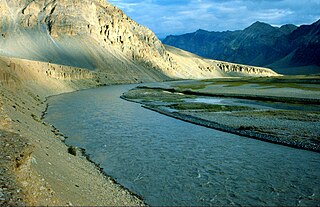
The Doda River or the Stod River is a river 79 kilometres (49 mi) long, which forms the Stod Valley in the Zanskar valley of the Ladakh region in the Indian state of Jammu and Kashmir.
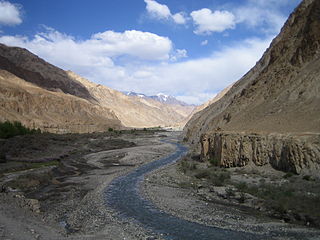
The Markha River is a river in Ladakh, India. It is a tributary of the Zanskar River and starts at the junction of the Langtang Chu and Nimaling Chu. Villages along the river valley include Skiu (Skyu), Markha, Umlung and Hangkar (Hankar). The Markha River lies within Hemis National Park.

Hassanabad is a village in Chorbat, Ghangche District of Gilgit-Baltistan, Pakistan, lying 141 kilometres (88 mi) east of Skardu, near the border of India. The ancient name of Hassanabad was Kusting, which means a large storage of water. The language spoken is Balti. The entire population is Muslim of the Sofia Noorbakhshia In the past it was the trade route to Ladakh and Kargil.
Burji La is a natural pass in mountains between Skardu and Deosai National Park in Gilgit Baltistan, Pakistan. Its elevation is 5000 meters. It is famous especially for its beautiful panoramic view of so many mountain peaks, including that of K2, Nanga Parbat, Masherbrum, Chogolisa, Laila Peak, Golden Peak, Gasherbrum I, Gasherbrum II, Gasherbrum IV and a part of Broad Peak mountain.



















